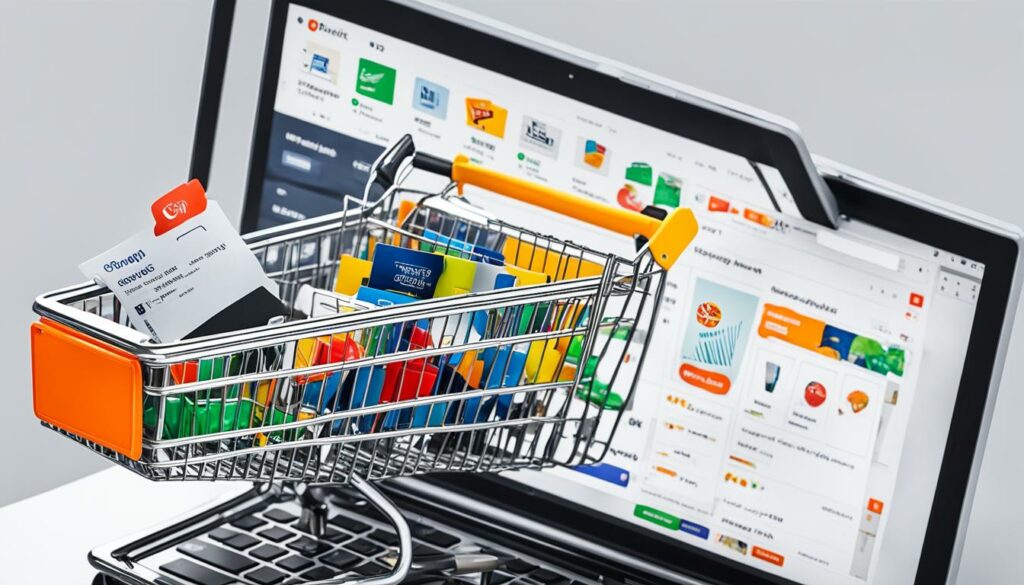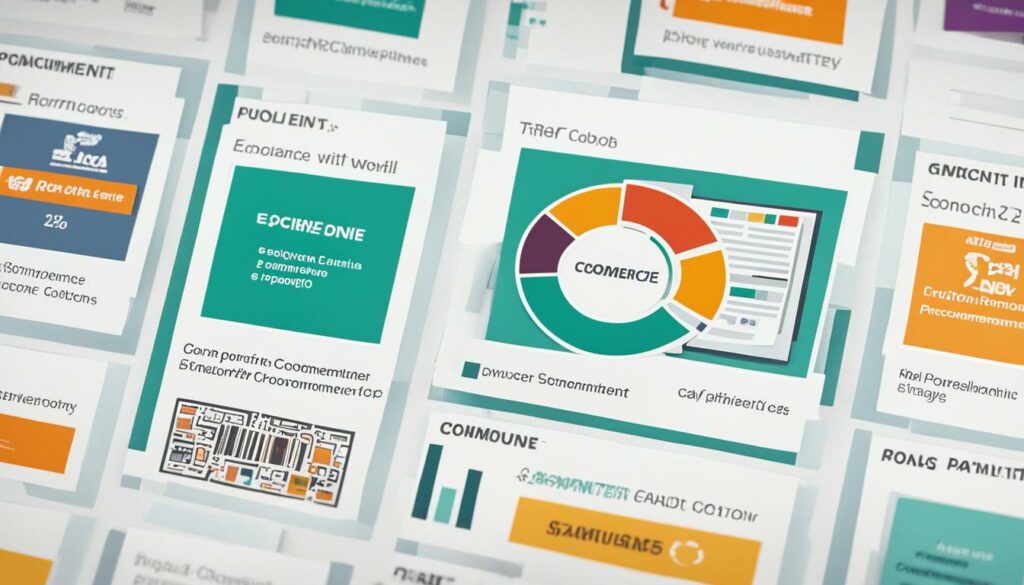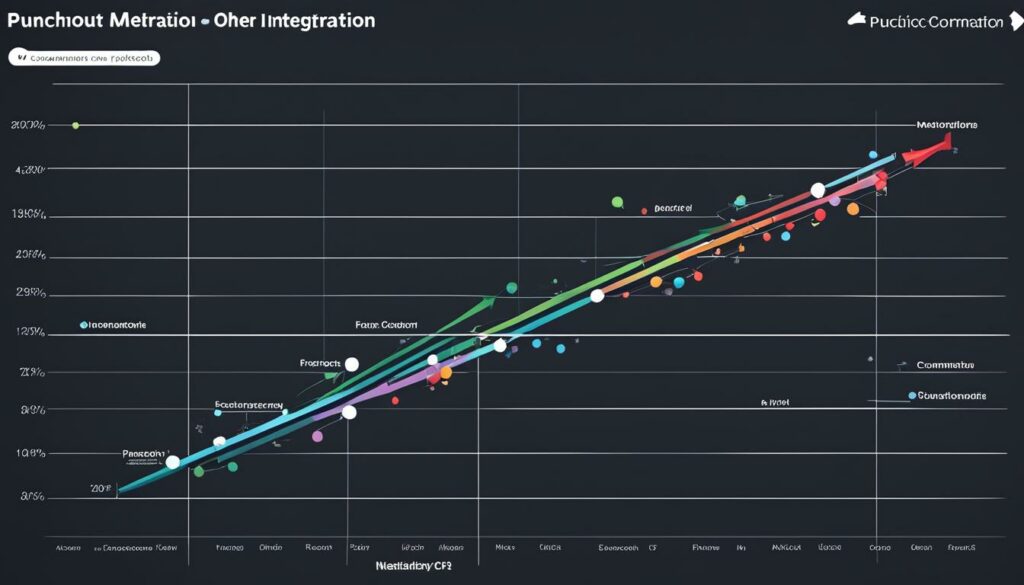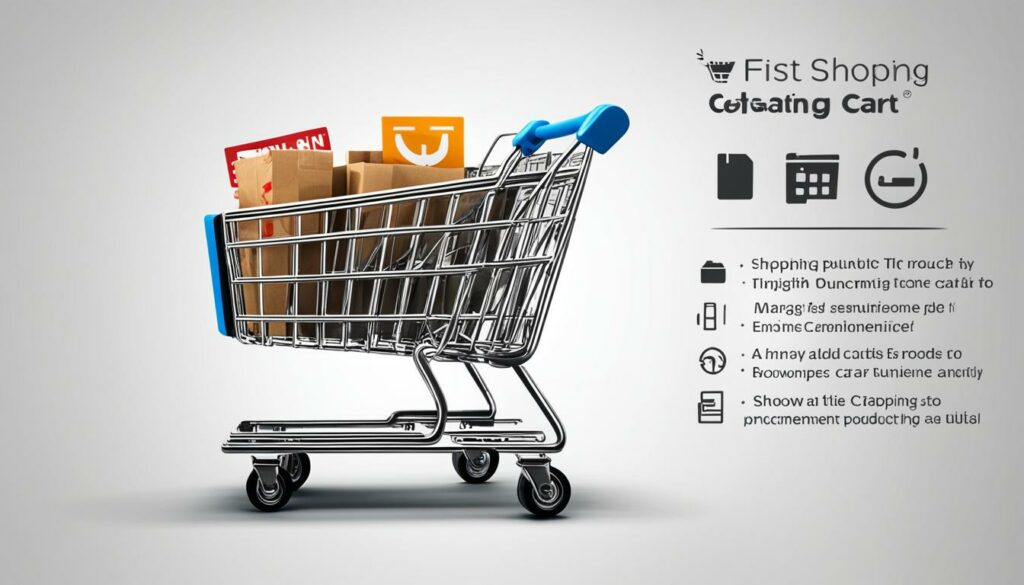Have you ever wondered what punchout in ecommerce means? In the world of B2B purchasing, punchout catalogs have revolutionized the way buyers and sellers interact. By seamlessly integrating procurement systems with ecommerce stores, punchout catalogs allow buyers to access supplier catalogs and make purchases right from their eProcurement platform.
In 2021, eProcurement accounted for 8.5% of all US digital commerce sales and 7.1% of total B2B sales. This shows the growing importance of streamlining the purchasing process and finding efficient ways to connect buyers and sellers. Punchout catalogs have gained popularity due to their ability to automate procurement processes, increase efficiency, and improve the overall buying experience in the B2B space.
Key Takeaways:
- Punchout in ecommerce integrates procurement systems with ecommerce stores
- Punchout catalogs allow buyers to access supplier catalogs and make purchases from their eProcurement platform
- EProcurement accounted for 8.5% of US digital commerce sales in 2021
- Punchout catalogs automate procurement processes and increase efficiency in the B2B purchasing process
- Punchout catalogs improve the overall buying experience for buyers
Definition of Punchout in Ecommerce
Punchout in ecommerce refers to the integration of a supplier’s ecommerce store with a buyer’s eProcurement system, allowing buyers to access the supplier’s catalog and make purchases without leaving their eProcurement platform.
The punchout process involves authentication, seamless data transfer between platforms, and the ability for buyers to browse, compare, and purchase products from the supplier’s ecommerce store. This integration is made possible through custom integrations or cloud gateways that mediate communication between the platforms.
| Punchout Solution | Punchout Functionality |
|---|---|
| Enables buyers to access supplier catalogs | Allows buyers to browse, compare, and purchase products |
| Seamless integration with eProcurement systems | Authentication process and data transfer |
| Custom integrations or cloud gateways | Mediates communication between platforms |

“Punchout in ecommerce seamlessly integrates supplier catalogs with eProcurement systems, allowing buyers to effortlessly browse, compare, and make purchases within their familiar eProcurement platform.”
Streamlining the Procurement Process
Punchout functionality streamlines the procurement process by eliminating the need for buyers to manually switch between multiple platforms. With a punchout solution, buyers can access the supplier’s catalog directly within their eProcurement system, reducing errors, improving efficiency, and saving valuable time.
Enhanced Buyer Experience
Punchout functionality enhances the buyer experience by providing real-time access to accurate product data, pricing, and availability. Buyers can easily compare products, access negotiated pricing, and take advantage of any discounts offered by the supplier, resulting in a seamless and personalized shopping experience.
Increased Efficiency and Cost Savings
Punchout functionality automates the procurement process, reducing manual efforts and ensuring up-to-date information. This automation leads to increased efficiency, reduced processing costs, and improved order accuracy. By leveraging punchout catalogs, businesses can optimize their procurement operations, resulting in significant time and cost savings.
In the next section, we will explore the importance of punchout in ecommerce and the benefits it offers to both buyers and sellers.
Importance of Punchout in Ecommerce
Punchout in ecommerce plays a crucial role in streamlining the procurement process and enhancing efficiency for both buyers and sellers. Its integration allows buyers to have real-time access to accurate product data, pricing, and availability, eliminating manual errors and ensuring up-to-date information.
One of the key benefits of punchout procurement is its ability to enable cost-efficient procurement. By automating the procurement process, punchout catalogs help reduce processing costs and improve order accuracy, resulting in significant savings for businesses.
In addition to improving the procurement process, punchout catalogs also enhance the buyer’s shopping experience. They provide buyers with a seamless shopping interface within their eProcurement platforms, allowing them to browse, compare, and purchase products from suppliers without leaving their familiar environment.
Furthermore, punchout shopping provides significant benefits in terms of buyer retention and fraud protection. Buyers can select vendors based on their preferences, ensuring better control over pricing and quality. This not only leads to increased buyer retention but also protects buyers from potential fraudulent activities.
Overall, punchout in ecommerce offers a range of benefits such as streamlined procurement, cost efficiency, enhanced shopping experience, buyer retention, and fraud protection. These advantages make punchout a valuable tool for businesses operating in the B2B ecommerce sector.
Strategies to Improve Punchout in Ecommerce
To enhance punchout in ecommerce, B2B sellers can implement several strategies to improve the integration process and optimize the overall experience for both suppliers and buyers.
Offer Third-Party Integration Services
One way to make it easier for suppliers to integrate into punchout catalogs is by offering third-party integration services. These services can provide a seamless connection between the supplier’s ecommerce platform and various eProcurement systems, eliminating the need for custom integration development. By collaborating with reliable integration providers, B2B sellers can streamline the onboarding process for suppliers and accelerate the implementation of punchout catalogs.
Develop Custom Integrations
In addition to third-party integration services, B2B sellers can also develop their own custom integrations to accommodate specific eProcurement platforms. This requires technical expertise and an understanding of the different integration protocols and requirements of various systems. By investing in custom integration development, sellers can ensure compatibility with a wide range of eProcurement platforms, expanding their potential customer base and making it easier for buyers to access their punchout catalogs.
Provide Training and Support for Sales Teams
Training and support for sales teams are crucial in effectively pitching and promoting punchout catalogs to buyers. B2B sellers should equip their sales teams with comprehensive knowledge about the benefits of punchout integration and how it enhances the procurement process. This includes understanding the technical aspects, such as authentication and data transfer, as well as effectively communicating the value proposition to potential buyers. By ensuring that sales teams are well-trained and supported, sellers can increase the adoption of punchout catalogs and drive business growth.
Enhance Ecommerce Platforms
Creating a user-friendly and intuitive ecommerce platform is essential for attracting and retaining buyers. B2B sellers should focus on enhancing their ecommerce platforms to provide a seamless and engaging experience similar to consumer ecommerce websites. This includes ensuring responsive design, intuitive navigation, advanced search capabilities, and personalized product recommendations. By offering a user-friendly interface and enriching the browsing and purchasing experience, sellers can entice buyers to utilize the punchout catalog and increase sales.

Summary of Strategies to Improve Punchout in Ecommerce
| Strategies | Benefits |
|---|---|
| Offer third-party integration services | – Simplify integration process for suppliers – Accelerate onboarding of punchout catalogs |
| Develop custom integrations | – Ensure compatibility with eProcurement platforms – Expand customer base |
| Provide training and support for sales teams | – Enhanced sales pitch and value proposition – Increased adoption of punchout catalogs |
| Enhance ecommerce platforms | – Improve user experience – Increase sales conversion |
By implementing these strategies, B2B sellers can optimize the integration and usage of punchout catalogs, attracting new business, retaining existing customers, and gaining a competitive advantage in the market.
Customer Behavior and Punchout in Ecommerce
Customer behavior plays a crucial role in the success of punchout in ecommerce. The ease of use, convenience, and personalized experience offered by punchout catalogs greatly influence buyer preferences and decisions. Suppliers that provide punchout solutions understand the value of seamless integration with eProcurement systems, saving customers time and effort by eliminating the need to switch between platforms.
Punchout shopping enables buyers to access personalized catalogs, view real-time product data, and take advantage of negotiated pricing and discounts. This level of customization and real-time information empowers customers to make well-informed purchasing decisions. By tailoring punchout catalogs to meet the individual needs and expectations of buyers, suppliers can enhance customer satisfaction and foster loyalty.
Understanding customer behavior and preferences is vital for optimizing punchout in ecommerce. By monitoring and analyzing user interactions, suppliers can identify patterns, preferences, and pain points. This data-driven approach allows businesses to make informed decisions about catalog content, layout, and overall user experience, shaping the punchout integration to align with customer expectations.
By tailoring punchout catalogs to meet the individual needs and expectations of buyers, suppliers can enhance customer satisfaction and foster loyalty.
Personalized Catalogs and Real-Time Data
Punchout catalogs enable buyers to access customized catalogs that are tailored to their specific preferences and requirements. This personalization enhances the overall shopping experience and empowers customers to find the products they need quickly and efficiently. Additionally, real-time data integration ensures that buyers have access to accurate and up-to-date information about availability, pricing, and product details.
Improved Efficiency and Cost Savings
Punchout in ecommerce streamlines the purchasing process, resulting in improved efficiency and cost savings for buyers. By seamlessly integrating their eProcurement system with punchout catalogs, buyers can automate procurement processes, reducing the need for manual data entry and paperwork. This automation not only saves time but also reduces the likelihood of errors, ensuring order accuracy and minimizing the risk of costly mistakes.
Enhanced User Experience and Loyalty
Punchout shopping offers buyers a seamless and intuitive shopping experience, similar to consumer ecommerce platforms. This familiarity and ease of use contribute to increased customer satisfaction and loyalty. Additionally, punchout catalogs provide buyers with control over vendor selection, allowing them to choose suppliers based on their individual needs and preferences. The ability to access negotiated pricing and discounts further enhances the value proposition for buyers, fostering long-term relationships and repeat business.
| Benefits of Customer Behavior in Punchout Ecommerce | Value Proposition for Buyers |
|---|---|
| Personalized catalogs and real-time data | Quick access to tailored product information and availability, ensuring a personalized shopping experience. |
| Improved efficiency and cost savings | Automation of procurement processes reduces manual effort, saves time, and minimizes the risk of errors. |
| Enhanced user experience and loyalty | Familiarity, seamless shopping experience, and access to negotiated pricing create customer satisfaction and encourage repeat business. |
Relation to Other Ecommerce Metrics
Punchout in ecommerce is closely related to several other crucial ecommerce metrics, including sales channels and procurement processes. As one of the fastest-growing B2B sales channels, punchout catalogs play a significant role in the overall landscape of US digital commerce sales and total B2B sales.
By incorporating punchout catalogs into eProcurement platforms, businesses can automate procurement processes and gain valuable insights into purchasing behaviors. This integration allows for streamlined transactions and a more efficient workflow, resulting in enhanced sales and procurement efficiency.
To optimize their overall ecommerce strategy and improve their bottom line, businesses should analyze ecommerce metrics associated with punchout integration. By closely monitoring key performance indicators like conversion rates, average order value, and customer acquisition costs, businesses can make data-driven decisions and identify opportunities for improvement.
Key Ecommerce Metrics
- Sales channels: Identify which sales channels generate the highest revenue and conversion rates.
- Conversion rates: Measure the percentage of website visitors who complete a desired action, such as making a purchase.
- Average order value: Determine the average dollar amount spent by customers per order.
- Customer acquisition costs: Assess the expenses incurred to gain new customers.
Understanding the impact of punchout catalogs on these ecommerce metrics allows businesses to fine-tune their strategies and allocate resources effectively. By leveraging the power of punchout integration, businesses can optimize sales channels, increase conversion rates, boost average order value, and reduce customer acquisition costs, resulting in a more successful B2B ecommerce operation.
“Efficient punchout integration enhances sales and improves procurement processes, resulting in better ecommerce metrics and a stronger bottom line.” – [Author Name]
| Ecommerce Metrics | Impact of Punchout Integration |
|---|---|
| Sales channels | Expansion of B2B sales channels and increased revenue. |
| Conversion rates | Optimized purchasing experience leading to higher conversions. |
| Average order value | Access to personalized catalogs and negotiated pricing influencing higher purchase values. |
| Customer acquisition costs | Efficient procurement processes reducing customer acquisition costs. |

Challenges and Considerations of Punchout in Ecommerce
While punchout catalogs offer numerous benefits, there are also challenges and considerations to be aware of. One challenge is the compatibility and mapping issues between different eProcurement and ecommerce platforms, which can make integration more complex and expensive. Building and maintaining punchout integrations in-house can be difficult and time-consuming, requiring technical expertise and ongoing support. Scalability can also be a challenge, as each unique integration requires its own custom-built solution. Businesses should carefully consider the cost, resources, and technical requirements before implementing punchout in ecommerce.
| Challenges | Considerations |
|---|---|
| Compatibility and mapping issues | Cost, resources, and technical requirements |
| Building and maintaining in-house integrations | |
| Scalability for unique integrations |
Conclusion
Punchout in ecommerce is a powerful tool that seamlessly integrates procurement and ecommerce, providing B2B customers with streamlined access to supplier catalogs. By implementing punchout catalogs, businesses can enjoy a range of benefits, including cost-efficient procurement processes, increased order accuracy, improved customer experiences, and enhanced buyer retention. However, it is important to note that there are challenges to consider, such as compatibility issues, implementation complexities, and scalability concerns.
Despite these challenges, by understanding and addressing them, businesses can effectively leverage punchout catalogs to optimize their B2B ecommerce strategies and gain a competitive edge in the market. By ensuring compatibility with various eProcurement and ecommerce platforms, offering training and support for sales teams, and focusing on enhancing their ecommerce platforms, businesses can attract new customers, retain existing ones, and drive growth through punchout integration.
Overall, punchout in ecommerce offers a comprehensive solution for integrating procurement and ecommerce processes, enabling businesses to enhance their efficiency, reduce errors, and provide a seamless buying experience for B2B customers. By embracing the power of punchout catalogs and addressing the associated challenges, businesses can unlock the full potential of B2B ecommerce and position themselves for success in today’s competitive market.
FAQ
What is Punchout in Ecommerce?
Punchout in ecommerce refers to the integration of a supplier’s ecommerce store with a buyer’s eProcurement system, allowing buyers to access the supplier’s catalog and make purchases without leaving their eProcurement platform.
What is a punchout catalog?
A punchout catalog is a method of integrating procurement systems with ecommerce stores, providing buyers with seamless access to supplier catalogs and the ability to make purchases from within their eProcurement platform.
How does punchout integration work?
Punchout integration involves authentication, seamless data transfer between platforms, and the ability for buyers to browse, compare, and purchase products from the supplier’s ecommerce store while remaining within their eProcurement platform.
What are the benefits of punchout in ecommerce?
Punchout catalogs offer benefits such as cost-efficient procurement, increased order accuracy, improved customer experience, enhanced buyer retention, and fraud protection through control over vendor selection and pricing.
How can businesses improve punchout in ecommerce?
Businesses can improve punchout in ecommerce by offering third-party integration services, implementing custom integrations, ensuring compatibility with different eProcurement platforms, and enhancing their ecommerce platforms to provide a user-friendly experience.
How does customer behavior relate to punchout in ecommerce?
Customer behavior in punchout ecommerce is influenced by the ease of use, convenience, and personalized experience offered by punchout catalogs. Buyers prefer suppliers that offer punchout solutions because they provide a seamless integration with their eProcurement systems, saving time and reducing manual effort.
How does punchout in ecommerce relate to other ecommerce metrics?
Punchout in ecommerce is considered one of the fastest-growing B2B sales channels, accounting for a significant portion of US digital commerce sales and total B2B sales. It integrates with eProcurement platforms, automates procurement processes, and provides insights into purchasing processes.
What are the challenges and considerations of punchout in ecommerce?
Challenges of punchout in ecommerce include compatibility and mapping issues between different platforms, the complexity and cost of integration, and scalability for unique integrations. Businesses should carefully consider the resources, cost, and technical requirements before implementing punchout.
